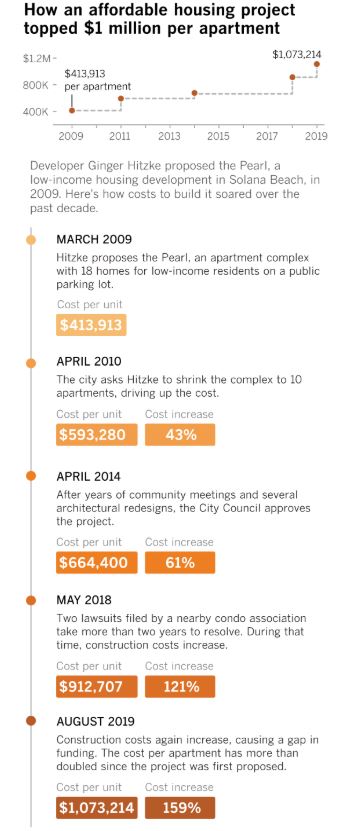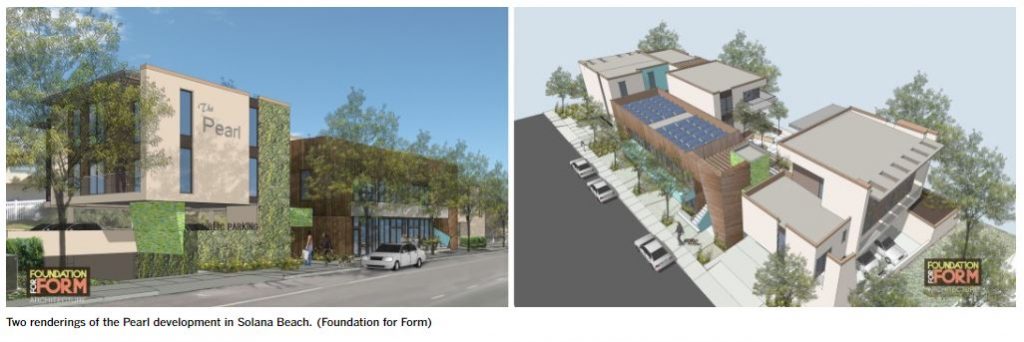When developer Ginger Hitzke first proposed an affordable housing complex on a parking lot in Solana Beach, she envisioned building 18 new homes for low-income families and adults at a cost of $414,000 per apartment.
More than a decade later, her project has shrunk in size by nearly half and become more than twice as expensive.
At $1.1 million per apartment, the Pearl is the priciest affordable housing project in the state and, likely, the country. It also serves as an alarming example of how political, economic and bureaucratic forces have converged to drive up the cost of such housing at a time when growing numbers of Californians need it.
“I have sticker shock,” Hitzke said. “It’s insane.”
Miguel Zamora’s saga, which is also the Pearl’s, began 30 years ago in a rundown, 1920s motel in Solana Beach, where he lived with his wife and four children. Hot water came and went, the roof leaked and toilets overflowed. Cockroaches, fleas and rats infested the rooms.
“It was all dirt. It wasn’t even paved. And it was quite ugly,” said Zamora, who worked in construction and as a dishwasher and gardener. “When it rained, it was really very cold. Everything would get damp.”
In 1992, the city of Solana Beach filed a criminal complaint against the motel’s Beverly Hills-based owner. As part of the settlement, the city demolished the motel, but agreed to provide Zamora’s family and more than half a dozen other residents new affordable housing by 1999.
Zamora and the others also received federal housing assistance vouchers, which helped him find an apartment five miles away from the old motel. His family has been living there for the last two decades, but the apartment they never received still weighs on his mind.
Should the Pearl or other low-income housing ever get built in the city, Zamora has the right to move in first. He longs to bring his family together in a place that feels more like home.
“I’d like to enjoy my grandchildren,” said Zamora, 67. “Because being apart is hard.”
Even though the deadline to provide the affordable housing was 1999, it took almost another 10 years for Solana Beach’s leaders to take the first step of asking developers to pitch projects.
Hitzke proposed building the Pearl on a 20,000-square-foot public parking lot, situated along a bluff on the same block as the old motel and a beach access point. The 18 apartments included enough three- and four-bedroom units to accommodate Zamora’s family and the others entitled to new housing.
Residents and the public would pay for parking in an underground garage, which would help finance the project, as would rent from a small grocery store. The Pearl would cost $414,000 per apartment to build.
City officials were intrigued but knew the idea would cause problems among Solana Beach’s 13,000 residents. The community has a median annual household income of more than $100,000. The parking lot sits on prime real estate, separated by a white fence from timeshare rentals. Across a tree-lined street is a three-story condominium complex where a two-bedroom unit recently sold for $1.2 million.
After a year of negotiations with the city, Hitzke agreed to shrink the Pearl to 10 apartments and make it free for the public to park in the 53-space garage. The redesign raised the price of the project to just under $600,000 per apartment.
At that point, Hitzke and city officials were ready to unveil the Pearl to Solana Beach’s residents. It didn’t go well.
“Low-income people tend to own cars that are in disrepair and ride motorcycles adding to the noise of a ‘lights out at 8 p.m. community,’” Marylyn Rinaldi, a neighboring condominium owner, wrote in 2011 in a letter to the City Council that was later cited in a lawsuit over the project.
Rinaldi and others said that affordable housing didn’t belong in their community, and flooded the council with complaints.
The Solana Beach City Council finally approved the Pearl at the end of a four-hour meeting in spring 2014.
Almost immediately, the association for the condominium complex across the street sued, arguing that the city couldn’t build housing on the land because the deed required it to be a parking lot. The condo association lost the case and an appeal, but it took 2½ years to resolve.
Afterward, Hitzke was able to win some tax credits from the state, but the legal delay presented her with a new challenge: construction costs.
She attributes nearly all the 62% increase in the price per apartment in the six years since the project was approved to labor and materials. Overall, the UC Berkeley study found that those costs have gone up 30% for California affordable housing projects in that time.
With a price tag of $1.1 million per apartment, Hitzke hasn’t had enough money to start building. The state and local governments have refused to give her the $1 million she still needed. And neighbors have never stopped fighting the development.
Ernest Kurschat, a resident of a timeshare next to the site proposed for the Pearl, wrote to oppose the project in 2018, speculating that the retail space in the building would be “a food stamp office for the low-income housing.”
Solana Beach leaders have continued to support the Pearl, however, contending much of the costs of building are unavoidable in a community where the median home value is $1.4 million.
Hitzke said she’d have enough money to build the development, which is less than a mile from a major commuter rail stop, if she didn’t have to include the large underground parking garage.
But City Councilman David Zito defended the garage. Even if Solana Beach were legally allowed to do away with the parking, he said, the city was “ethically, morally obligated” to replace it because of “residential harmony.” It’s the same reason he believed the Pearl’s height should fit in with the surrounding neighborhood — so it doesn’t remind people of notorious high-rise public housing.
“You start talking about big projects that are wholly affordable and people start thinking about ‘projects,’ right? Like Cabrini-Green in Chicago or something like that,” said Zito, the only elected official who voted to approve the Pearl who remains on the council. “That then turns into a whole different discussion.”
The Pearl’s funding requirements called for the building to be LEED-certified and for Hitzke to pay union-level wages for construction workers. The initial budget had left room for a profit. But as early as 2013, Hitzke realized that she wasn’t going to make any money on the deal.
Now it looks like the Pearl won’t happen at all.
In December, the state informed her that it was planning to pull her funding because the project hadn’t broken ground. A month ago, Hitzke met with city officials to tell them she wanted out of her development agreement.
“I am thrilled to be done with this thing,” Hitzke said. “It’s done nothing but kill me. But at the same time, I tried to do everything I could to get it done.”
Zamora and his family, meanwhile, are still waiting in their apartment five miles away. With the Pearl nearing its demise, the promise of housing in Solana Beach will continue to go unfulfilled.
These days, when he drives by his old community, he gets disappointed nothing has happened on the land.
“We left almost everything there, the ones who lived there,” Zamora said. “It’s sad to see the place so desolate.”
Link to latimes Article




